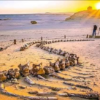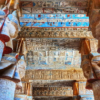The Temple of Edfu (the Temple of Horus at Edfu)
Takes its name from the city in which it is located, Edfu. The temple was dedicated to the god Horus and was constructed over 180 years, starting in 237 BC by Ptolemy III (Soter), whose name means ‘savior’ or giver,’ and was completed in 57 BC by Ptolemy XII, the father of Cleopatra.
The City of Edfu
In ancient times, the city of Edfu was known as “Edbu,” meaning “City of Food.” Over time, the name evolved into the more familiar “Edfu.” The Greeks referred to it as “Apollon Magna Polis,” or “Great City of Apollo,” as they united the Egyptian god Horus with the Greek god Apollo. The temple in Edfu is considered one of the most beautiful and complete Egyptian temples from the Ptolemaic period. It is situated on the west bank of the Nile River and was discovered in 1860 by the renowned French archaeologist Mariette. At the time of its discovery, the temple was buried beneath mud-brick houses and stables. Mariette purchased these properties and initiated excavations to uncover the temple.
The Significance of Edfu
In prehistoric times, the city of Nekhen (modern-day el-Kab) was located about 20 kilometers from Edfu, the capital of Upper Egypt. Nekhen held significant symbolic importance: most notably the white crown worn by its kings. This city was guarded by the goddess Nekhbet, represented as a vulture. The lotus flower served as its botanical emblem.
The Lotus Flower
For ancient Egyptians, the lotus flower held both divine and earthly significance. It symbolized the Nile River, mirroring its shape: the stem represented the river’s course, the flower itself symbolized the Nile Delta, and the leaves represented the river’s various branches. The lotus was also a symbol of purity, as it emerged from the mud, blossoming into a pristine white flower. Religious Significance: The lotus flower was associated with the sun, rebirth, and renewal. Consequently, ancient Egyptians frequently adorned the tops of columns with lotus flower motifs. Worldly Significance: The lotus flower was used in the creation of perfumes and served as a numerical symbol. One lotus was equivalent to a thousand, and two lotuses represented two thousand. Thus, the lotus flower has remained a symbol of Egypt to this day. Even when the Aswan High Dam was constructed in 1960, the lotus flower was chosen as its emblem.
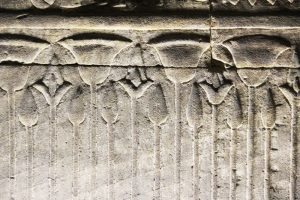
The reliefs’ details in the Temple of Horus in Edfu represent a lotus flower
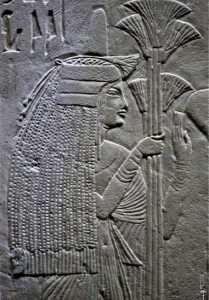

The sacred lotus flower for the ancient Egyptians
The God Horus
The triad of this temple consists of the god Horus, his wife Hathor, and their son Horus-Sematawy (Unifier of the Two Lands). The ancient Egyptians chose the falcon as a symbol for Horus for several reasons, most importantly:
• the falcon is the only bird that does not close its eyes in the face of the sun’s rays.
• Additionally, it Fly to heights that no other bird can reach, which led the Egyptians to associate it with the sun god Ra in the myth of the winged solar disk.
• The falcon was also seen as a noble creature because it only hunts live prey.
The Myth of the Winged Solar Disk
The myth tells of the sun god Ra, who, upon facing a rebellion led by the god Set, commanded Horus to quell the uprising. Horus, typically depicted as a falcon, was empowered by Ra with the attributes of the sun, resulting in a fusion that symbolized Horus as the winged sun. Horus successfully defeated Set and ended the rebellion. As a tribute to Horus, Ra ordered that the winged solar disk be inscribed on the facades of all Egyptian temples. Horus thus became the guardian deity of all Egyptian kings, and every pharaoh was considered the son of Horus, ruling on his behalf.

Image of the winged disk of the sun
Description of the Temple
The temple was connected to the Nile River via a small canal, and thus had a nilometer to measure the river’s level for the purpose of determining taxes.
The Birth House (Mammisi)
Ancient Egyptians traditionally recounted the myth of Isis, Osiris, and the birth of Horus within their temples. However, during the Ptolemaic period, they began constructing a special enclosure next to each temple, known as the birth house (mammisi). The mammisi in this particular temple was built by Ptolemy VIII. It consists of a front hall with two chambers and a colonnade adorned with images of the god Horus being nursed by the cow goddess Hathor. There is also a beautiful scene depicting the seven Hathors playing drums in celebration of Horus’ birth.
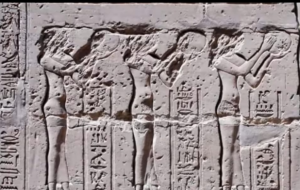
A picture of the seven Hathors playing on tambourines to celebrate the birth of Horus
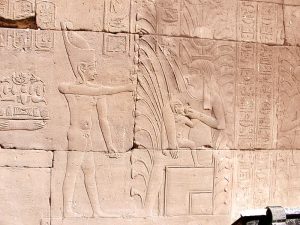
A scene of breastfeeding from Mother Hathor, engraved on the walls of the Great Hall of Columns
The Temple’s Facade (Pylon)
The facade consists of two massive towers flanking the entrance to the temple, reaching a height of 36 meters. A winged solar disk crowns the structure. The towers are symbolic of the Eastern and Western Mountains of Egypt, between which the sun rises. In front of the pylon stand two colossal granite statues of Horus in the form of a falcon. Between the falcon’s legs is a smaller statue, believed to represent a prince of Edfu at the time. The most prominent inscriptions on the temple’s facade depict King Ptolemy XII (Neos Dionysos), the father of Cleopatra, swipe his enemies before the gods Horus and Hathor. In these scenes, the king offers Horus a dagger to sever the heads of his enemy. Above these scenes, there are depictions of the king making offerings to Horus and Hathor. Additionally, there are openings on each tower for the hoisting of flags.

The main entrance to the temple shows two granite statues of Horus with a double crown in front of it

A picture of King Ptolemy XII attacking his enemies before the god Horus
The Open Court:
The ancient Egyptians divided their temples into specific sections. The innermost part, known as the Holy of Holies, was reserved for the pharaoh alone. Due to the pharaoh’s frequent absences, the high priest would perform the daily rituals and enter the Holy of Holies to change the god’s statue’s clothing and adorn it with pure gold. Before the Holy of Holies was the hypostyle hall, accessible to priests and high-ranking officials during festivals and special occasions. The third and outermost part of the temple was the open court, where we stand now. This area was called the “court of libations” because it was where sacrifices were made to the gods and offerings of wine were poured out. It was accessible to the general public, who could come to make offerings or simply to enjoy a meal in the presence of the gods.
The Open Court Explained
Upon entering the temple through the gateway, one encounters numerous scenes and inscriptions. A particularly striking feature is the presence of open cartouches without names. Some scholars believe this was due to the power struggle between Ptolemy V and Ptolemy VI, which made the priests hesitant to inscribe the name of either ruler. The court is supported by 32 columns, whose capitals display a blend of Egyptian and Greco-Roman styles. While Egyptian columns typically featured lotus or papyrus capitals, Greco-Roman columns often had palm leaf or floral motifs. Here, we see the columns adopting a cylindrical shape, representing the plant’s stem, while the capitals, representing the flower, take on various forms such as palm leaves, floral bouquets, lotus blossoms, or papyrus. A series of scenes depicts the sacred journey of Hathor to visit her husband Horus in his temple at Edfu. She travels from Dendera in a grand procession led by the king, who initiates the rituals. These scenes are depicted on the eastern and western walls of the open court. On the eastern wall of the southern colonnade, we see the king emerging from his palace wearing the white crown of Upper Egypt, preceded by a priest burning incense. The four standards of Upper Egypt flutter behind him, while the gods Thoth and Horus purify him. The goddesses Nekhbet and Wadjet, adorned with the double crown, present him with a scepter in the presence of Atum. On the western side of the entrance, a similar scene unfolds, but this time the king wears the red crown of Lower Egypt.
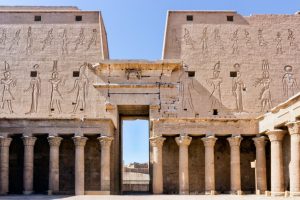
A picture showing the inscriptions of the front edifice from the inside, which bears inscriptions of Ptolemy XII (the Piper) offering sacrifices to the various Egyptian gods.
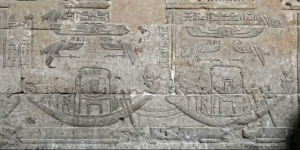
An inscription illustrating the sacred journey of Hathor visiting her husband, Horus
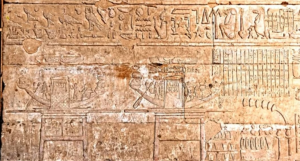
An inscription illustrating the sacred journey of Hathor visiting her husband, Horus
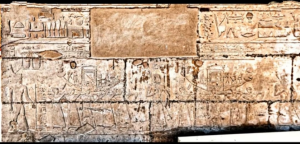
A portrait of the king wearing a red crown on the western wall of the open courtyard
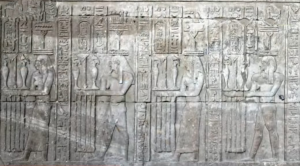
Image of the god Hapi, the god of the Nile, offering sacrifices to the god Horus
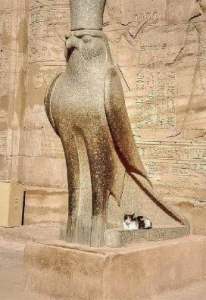
statue of Horus in the form of a falcon A
The Great Hypostyle Hall
Comprised of 12 columns, the hypostyle hall is adorned with numerous inscriptions. On the eastern wall, we see Ptolemy IX offering a sacrifice to Horus. On the western wall, the king is depicted spearing his enemy, represented as a hippopotamus, before the deity Osiris. A particularly significant scene on the left side of the entrance shows the king founding the temple. Before him stands the goddess Seshat, goddess of writing and astronomy, as he selects the four corners of the temple then in each corner, the king deposits what are known as foundation deposits. The ancient Egyptians traditionally chose the four corners of a temple and determined its dimensions before placing foundation deposits in each corner. An ancient Egyptian custom, still practiced today, involved sacrificing an animal and dipping hands in its blood, which was then smeared on the foundation or nearest wall to ward off evil spirits. This custom has evolved, and today people place silver or blue hands on their homes or cars as a protection against the evil eye. You will see examples of this on the horse-drawn carriage that will take you from the temple. Important Chambers: On the right, there is a chamber known as the library Room, which housed papyrus scrolls containing records of the temple. Above the doorway, the five senses are depicted. To the north lies the chamber of consecration, where the morning rituals of purification were performed on the king. The ceiling of the hypostyle hall is black. This is attributed to the early Christian period when Christianity was recognized as the state religion in the 4th century AD. Some Christians lived in this area and used it for cooking, hence the blackening of the ceiling. Additionally, we can see intentional damage to the scenes, particularly on the western wall. The Christians who lived here believed that the ancient Egyptians worshiped animals, and thus deliberately defaced the images of Egyptian deities depicted as animals.
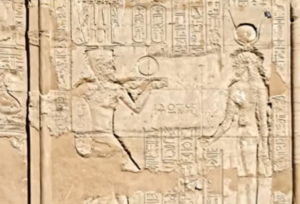
Scenes of the king making offerings on the façade of the Great Hypostyle Hall
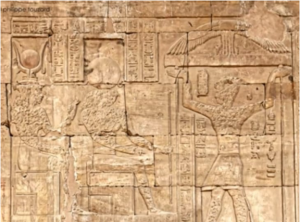
Scenes of the king making offerings on the façade of the Great Hypostyle Hall
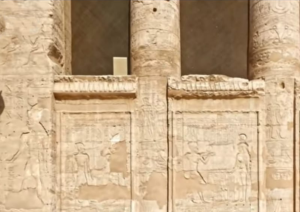
Scenes of the king making offerings on the façade of the Great Hypostyle Hall

Scenes of the king making offerings on the façade of the Great Hypostyle Hall
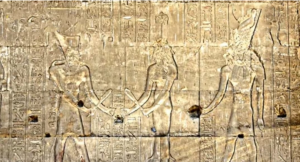
The king and the god Seshat lay the founding stone of the temple
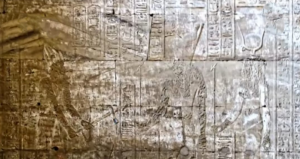
The king grabs an ax and marks the four corners of the temple
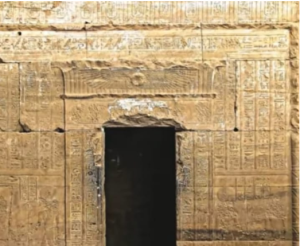
Picture of the dedication room
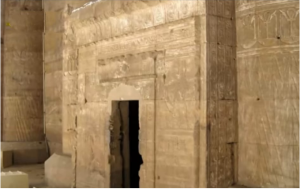
Picture of the library room
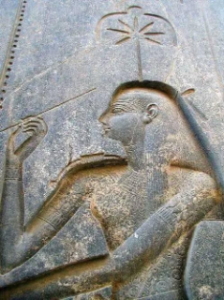
Image of the goddess Seshat, goddess of writing and astronomy
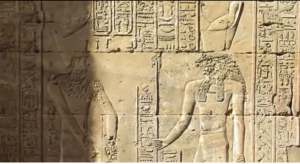
The image distorts the scenery of kings
The Small Hypostyle Hall
Composed of 12 columns, the small hypostyle hall is distinguished by the depictions of the sacred boat carried on the shoulders of priests. There are also two representations of the king: one in his royal attire and the other as the high priest of the temple. This hall contains four doors on the eastern and western sides:
• Eastern Side: One door leads to the chamber of solid offerings, such as bread, pastries, and sweets. Precious stones were also stored here, and the walls were adorned with various designs of jewelry and amulets. The golden necklaces worn by the high priest each morning for the god’s statue were kept in this chamber.
• Eastern Side: Another door leads to the temple’s nilometer (a device used to measure the water level of the Nile). The walls of this chamber are inscribed with texts related to rituals and ceremonies.
• Western Side: One door leads to the chamber of holy water. The inscriptions depict the king with the Nile god Hapi offering holy water to Horus and Hathor.
• To the north of this chamber is the laboratory. Its walls are covered with intricate inscriptions describing medical recipes and perfume formulas. The king is depicted offering perfumes to the deities of Edfu, and there are also scenes of floral offerings. The guardian deity of this chamber is the perfume god, Seshenu, depicted as a lion-headed man holding a knife.
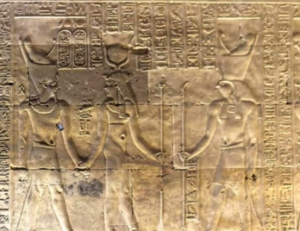 Image of the king in front of the god Hathor and Horus
Image of the king in front of the god Hathor and Horus
 Image of the king offering sacrifices to the boat of the god Horus
Image of the king offering sacrifices to the boat of the god Horus
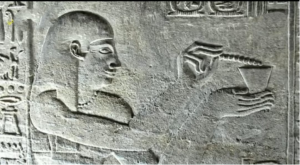
Image of perfume god Seshenu
The Hall of Offerings
Located towards the north, facing the Holy of Holies, this hall is connected to the surface by two staircases: a spiral one in the east used for ascending and a straight one in the west used for descending. This indicates the ancient Egyptians’ deep understanding of the nature of the falcon, which soars horizontally in a gradual (spiral) manner and descends vertically, i.e., straight. On the wall are lists of offerings presented to the gods, appearing in the form of cows or calves, in addition to the image of the ram associated with the deity Khnum. After that, we reach the Hall of the Ninth Day, where the gods are gathered on the festival day or the day of the main processions.
Pictures of The Hall of Offerings
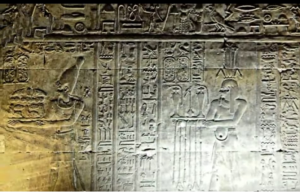
Pictures of The Hall of Offerings
 Pictures of The Hall of Offerings
Pictures of The Hall of Offerings

Nut’s Chamber (Goddess of the Sky)
To the right of the Holy of Holies, we find Nut’s chamber, dedicated to the New Year celebrations. Here, the statues of Alba (soul) are united with Alka (spiritual double of human) on New Year’s Day. We see an inscription of the goddess Nut on the ceiling, depicted as a lady the length of the view, lying on her stomach. Her hands and feet represent the east, west, north, and south. Inside, there are twelve boats representing the twelve constellations of the sky. On the wall, there are scenes of one of the Ptolemaic kings and his wife offering sacrifices to the goddess Nut on New Year’s Day.

Scene from Nut’s Chamber
The Holy of Holies
It is the most important part of the temple, as it is the place designated for the statue of the god, meaning it is a symbolic place of rest for the god. Therefore, none enter it except the son of the god, who is the king, or his representative, who is the high priest. This is to perform the daily service rituals for the statue of the god, such as changing clothes, burning incense in front of it, and adorning it with a golden breastplate daily. Gold, for the ancient Egyptians, was a symbol of eternity because it never corrodes. Therefore, they made statues of the gods from gold because the bodies of the gods are imperishable. The Holy of Holies in any temple is the first place to be established, and it was always made with a wooden door plated with bronze. The walls of the Holy of Holies are always depicted from below with a view of the god Hapi, the god of the Nile, 42 times, symbolizing the provinces of Egypt. And the rest of the scenes on the walls depict the king offering various sacrifices to the god Horus, the owner of the temple. In the middle, we always find a single large stone base on which the sacred boat of the god is placed. And at the end of the Hall of the Holy of Holies, we find a granite sarcophagus dating back to the reign of Nectanebo II (332 BC). It contained a statue of the god Horus, which was made of gold.
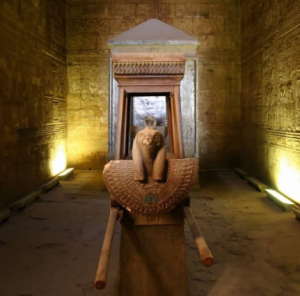
The sacred boat of the god Horus and behind it the granite sarcophagus from the era of Nectanebo, 232 BC
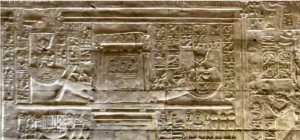
A view on the walls represents the sacred boat, which is on the stone base in the Holy of Holies. We notice that in the middle of it is a compartment in which the golden statue of the god is placed. At the beginning and end of the boat we see pictures of the god Hathor, who visits her husband in his temple.
Around the Holy of Holies, A corridor with 10 rooms was dedicated to some major gods other than Horus and was also used as storages For sacred things such as fabrics, clothes, and others. These rooms contain Basements devoid of scenes.
The most important of these rooms are
The room of the avenging trinity (the room of the flame)
The room of Ra (the chamber of the sun’s throne)
The room of Khonsu and Hathor (the room of the leg)
The room of Horus (the palace of courage)
The wing of Osiris
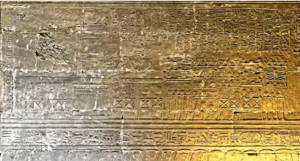
The room of the avenging trinity (the room of the flame)
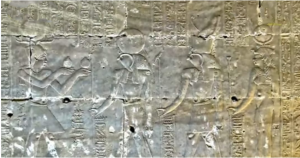
The room of Ra (the chamber of the sun’s throne)
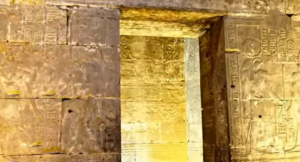
The room of Khonsu and Hathor (the room of the leg)
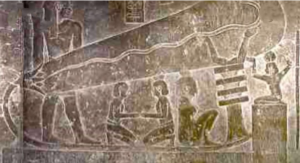
An image of the grandfather column of the god Osiris in the Osiris wing
The outer corridor around the Holy of Holies
The outer corridor encircling the Holy of Holies features a Nile meter on its eastern side. The eastern wall showcases inscriptions narrating the birth of Horus, while the opposite wall records the legend of his victory. The lower portion of the wall displays texts from the Edfu Temple. The northern wall depicts scenes of Horus’s coronation, showing him adorned with jewelry and placed in a shrine to initiate the coronation process.
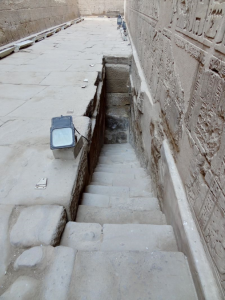
A picture showing the stairs leading to the Nilometer in the Temple of Edfu
On the western wall, there are scenes of the conflict between Horus and Seth (the legend of the conflict between Horus and Seth). The legend says that at the beginning of creation, the gods of the sky and earth gave birth to four children who were the first to inhabit the earth, namely Osiris, his wife Isis, his brother Seth, and his wife Nephthys. The creator god, Atum, commanded that Osiris become the king of the gods on earth. Seth, his brother, envied him and held a feast. He made a golden coffin to fit his brother Osiris and said at the feast, “Whoever the coffin fits, let him take it as a gift from me.” When Osiris lay down in the coffin, Seth killed him, cut up his body, and scattered the pieces throughout Egypt. Isis and her sister Nephthys gathered the parts of the god Osiris. The last piece they found was his spine, which was called the ‘Djed pillar’ in the region of Philae. They found the head in Abydos, so he was buried in Abydos, and the Egyptians made his tomb a place of pilgrimage and blessing, and considered him the god of the dead. Before he was buried, Isis (the goddess of magic) brought him back to life, and she became pregnant by him and gave birth to their son Horus. (This is why we find in all Egyptian temples what is known as the birth of Horus or the Mammisi) Isis raised Horus away from his uncle Seth. When he grew up, he claimed his throne, but his uncle Seth refused. A battle ensued between them that lasted for 80 years and ended with Horus’s victory over Seth, and Horus sat on his father Osiris’s throne. The scenes of the conflict between Horus and Seth are depicted on the western wall in 11 scenes. Horus is depicted as a man with a falcon’s head, and Seth is depicted as a hippopotamus. One of the most beautiful scenes is that of Horus hunting a hippopotamus with a net, and another scene shows him hunting it with a spear. The most important event during this conflict is that Seth gouged out Horus’s eye. The god Thoth, the god of wisdom, restored it to him. Since then, the Eye of Horus has been considered a symbol of protection, and Horus has been considered the god who took the throne after his father, and every Egyptian king has been considered a son of Horus. On the wall opposite the western wall, there are basins with lion’s head-shaped facades at the top, and there are canopies below to protect the temple visitors and the inscriptions on the walls, as the priests used to perform a play and wear masks of Horus and Seth in this corridor, and the important visitors would watch them.
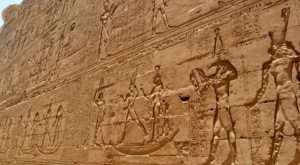
A picture of Horus inside his boat in his struggle with Set, assisted by his mother Isis, with the horns of a cow on her head, and the disk of the sun in between
 Horus’ supporters celebrate his victory over Set, and Horus slaughters a hippopotamus
Horus’ supporters celebrate his victory over Set, and Horus slaughters a hippopotamus
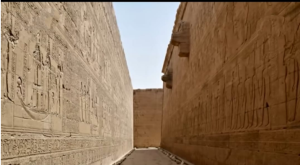
The image of the basins has a lion’s head shape on its front



